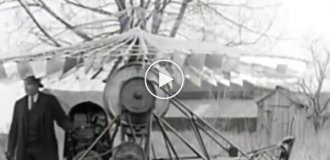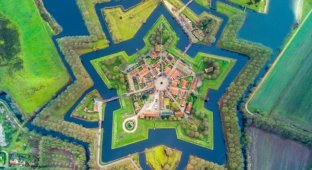The world's largest log cabin and its inglorious end (15 photos)
At the turn of the 20th century, Portland, Oregon, USA was a major economic hub with a thriving flour milling industry, lumber industry, and a rapidly growing seaport. 
Portland boasted the largest flour mill on the Pacific Coast. The logging industry was very developed due to Oregon's vast forests. Portland's location at the confluence of the Willamette and Columbia Rivers gave it a deep port accessible to large ships. 
Despite its many positives, Oregon was not spared the long depression of the late 19th century. Jobs were being lost across the country as railroads grew too fast with weak banking systems and agricultural prices fell. In an attempt to boost the economy, some of Portland's wealthiest and most influential businessmen decided to organize a fair of unprecedented proportions. 
This is how the Lewis and Clark Centennial Exposition was organized in 1905. The exposition, which ran for four months, attracted more than 1.6 million visitors, with representatives from 21 countries taking part. The exhibition grounds were filled with dozens of buildings decorated with architectural delights such as domes, arched doorways, and red roofs. Italy had the largest pavilion, with a huge collection of marble statues. Germany and France also spent huge sums on their exhibits, with the latter presenting a replica of King Louis XIV's living room. 
Most of the buildings erected on the fairgrounds were temporary, constructed of plaster on wooden frames. The exception was the forestry building. It was a huge structure, 62 meters long, over 30 meters wide and 22 meters high. The organizers of the exhibition boasted that the Lesopark building was the largest log house in the world, and this is true: it was built from whole logs with the bark still intact. 
Most of the giant logs that made up the building were from old growth trees in Columbia County, Oregon. Some were up to 6 feet across. Inside the forestry building were colonnades made from 54 massive, rough-hewn fir logs. The logs supported a two-story central nave. 
The Forestry Building housed exhibits on the logging industry, local flora and fauna, and Native American photographs and artifacts. It featured exhibits on Oregon's abundant natural resources, as well as displays of taxidermy of the area's native animals. 
After the exhibit closed, the Forestry Building was purchased by the City of Portland and sat abandoned and neglected for many years. In 1914, it almost perished in a fire, but the quick response of the fire department prevented the fire from spreading. 
In the 1920s, negotiations began to dismantle and save the valuable logs, but the proposal was rejected. However, the state also refused to pay for the repairs. By then, the building had become a security risk and was closed to the public. In the late 1940s, another fire occurred. 
Finally, in the 1950s, the Chamber of Commerce raised enough money to begin repairing the colossal structure. An old logging truck and other equipment appeared on the premises. Very soon, the forestry building became a favorite excursion spot for local schoolchildren. Guests from other cities also liked to come here. 
On August 17, 1964, the forestry caught fire due to poor electrical wiring and burned to the ground. 
The flames were nearly ten stories tall. The sky was lit up for miles, and the neighborhood was engulfed in an orange glow. Windows on the entire south side of the Montgomery Park building were blown out. The heat was so intense that the windows were blowing out. Glass was falling onto the street below. Ash the size of large snowflakes was falling to the ground for more than a kilometer around the building. It was a surreal, amazing sight. 
After the fire, a group of citizens joined forces with timber industry leaders to create the Western Institute of Forestry to fill the void. A new building for the Western Institute of Forestry, designed by Oregon architect John Storrs, was built in Washington Park and opened to the public in 1971. In 1986, the building was renamed the World Forestry Center to reflect the center's new focus on forestry on a global scale. 





























